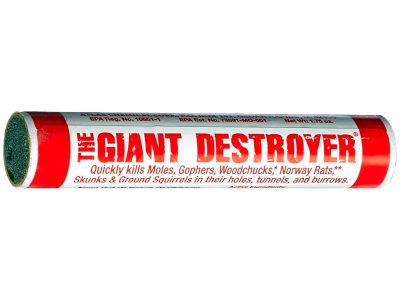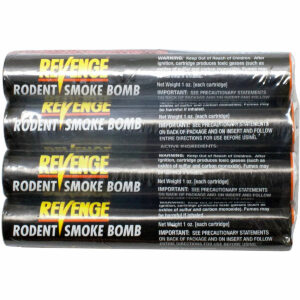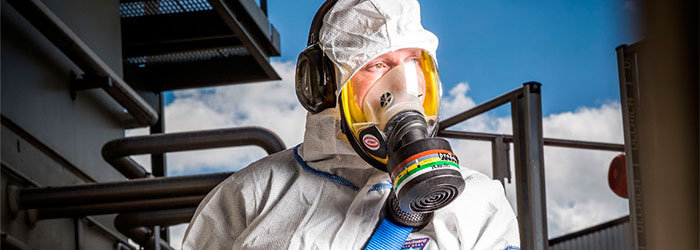Let’s now look at some of the smoke bombs you can purchase. After much research, some products stand out more than others. And the winner is Revenge Rodent Smoke Bombs.
[best_choice asin= “B000BQLWCS” tag=”pestkill-22″ locale=”com.au” name= “The Giant Destroyer” subname=” Working great on your mice problem” text=” The rodent smoke bomb emits thick, dense smoke that suffocates rodents in their burrows. It doesn’t cause secondary poisoning.
When carried out correctly, fumigation is one of the most efficient methods of mice control.”] [/best_choice]
[/best_choice]
Here are the Top 3 Best Bombs for Mice in Australia you can use to set off in the nesting sites of these furry, four-footed visitors:
| PREVIEW | PRODUCT | |
|---|---|---|
Our Top Pick [tablepress_img id="15778" alt="The Giant Destroyer (GAS KILLER) Super Gasser review"] | The Giant Destroyer (GAS KILLER) Super Gasser
| Check Price |
| [tablepress_img id="12015" alt="Revenge Rodent Smoke Bombs review"] | Revenge Rodent Smoke Bombs
| Check Price |
| [tablepress_img id="13198" alt="Amdro Gopher Gasser Sticks review"] | Amdro Gopher Gasser Sticks
| Check Price |
What is the Best Smoke Bombs for Mice in Australia in [current_date format=”Y”]? – Buyer’s Guide
There are several traps, baits, and poisons for eliminating mice at your disposal. An additional method you may want to consider is rodent bombs. Before investing money in them, you should have some essential facts. Here’s everything you need to know about using bombs for mice extermination.
You should take the presence of mice on your property seriously. They give birth to five or six young ones per litter, 5-10 times a year. That means two can turn into hundreds rapidly.
Mice are also vectors of several serious diseases. When they get into your home, they can bring with them some fleas, which are a vector for many conditions, including tapeworm infestation.
1. The Giant Destroyer – the Best Smoke Bombs in Australia (Editor’s Choice)
[amazon_item asin=”B000BQLWCS” tag=”pestkill-22″ locale=”com.au”] [/amazon_item]
[/amazon_item]
This gas killer kills rodents in their holes, caves, and tunnels. It comes with 4 tubes of gas bombs. You can extinguish the cartridge instantly with water. When ignited, this product releases sulphurous smoke that fills tunnels rapidly. It asphyxiates and kills the rodents inside the caves.
Where to use: Outdoors only. The product should only be used inside burrows. Never use inside buildings.

2. Revenge Rodent Smoke Bombs
[amazon_item asin=”B001MB7QVC” review=”https://pestkill.org/product/revenge-rodent-smoke-bombs/”] [/amazon_item]
[/amazon_item]
It contains a total of 4 smoke bombs. The bombs release sulphurous smoke to kill rodents.
Where to use: You can use the product on:
- lawns,
- golf courses,
- parks,
- meadows,
- non-crop areas,
- reforested areas,
- rangelands,
- open fields.
3. Amdro Gopher Gasser Sticks
[amazon_item asin=”B08SBXP6N3″] [/amazon_item]
[/amazon_item]
The product emits thick, dense smoke that suffocates rodents in their burrows. It doesn’t cause secondary poisoning.
Is It Effective to Use Bombs for Mice?
Ordinary bug bombs are designed for insects such as fleas, cockroaches, and flying insects. When opened, the insecticide inside the pressurized containers dissipates well over an open area and kills the insects occupying it. Most bombs contain pyrethrin, pyrethroid, or both as their active ingredients. They usually do not affect mice and other rodents.
Rodent bombs work like the other types of pest bombs. They involve the use of poisonous gases set in a sealed environment. The bombs are placed inside or near the mice’s nesting areas. The toxic fumes they emit kill the rodents.
You don’t always have to get rid of mice by killing them. You can also eliminate mice by repelling them. Go here to learn about the [link_webnavoz]best mouse repellent[/link_webnavoz]. The [link_webnavoz]best mouse poison[/link_webnavoz] is another way to eliminate them.
Using in my home
According to a few pest control experts, you can use these bombs inside your home, provided you follow all the safety precautions and read through any device instructions before setting them off. You’ll have to place the bombs in places you’ve frequently seen or heard mice or where their symptoms are consistent.
Most experts recommend using bombs outdoors only. Well, we agree. You can get very negative results using them indoors. No one should risk their family’s health or burn down their home in the name of pest control.
Mice Fumigation
When carried out correctly, fumigation is one of the most efficient methods of mice control. It’s used where rapid elimination of mice is required or if there’s a massive rodent infestation.
Fumigation is usually carried out in:
- outdoor burrows,
- boats and ships,
- grain silos.

Fumigants release a lethal gas that poisons or suffocates mice during air exposure. They’re highly hazardous materials. Using them requires special licensing and certification. Therefore, fumigation should always be done by a licensed technician.
Let’s look at some of the fumigants that can efficiently get rid of mice:
- Sulfur dioxide
Sulphur dioxide bombs kill mice through asphyxiation. When the gas comes into contact with the mucous membranes of the rodents, it’s converted into sulfuric and sulphurous acids. It damages the lungs and airways. Eventually, it causes collapsed lungs and respiratory arrest.
Rodents usually die by asphyxiation several minutes or hours after exposure to sulphur dioxide. The gas can also damage the mucous membranes of non-lethally affected animals. However, the harm it causes doesn’t last long. - Phosphine
Aluminum phosphide, as well as zinc phosphide, produces phosphine when they come into contact with water. Phosphine gas makes mice experience:
- shivering,
- piloerection,
- protruding eyeballs,
- convulsions,
- respiratory irritation,
- hindlimb paralysis.
Full paralysis and death follow eventually.
Mice normally begin being symptomatic around 30 minutes after exposure. They can die within 50 minutes to 3 hours depending on the dose of gas administered.
- Cyanide
Cyanide is a fast-acting toxin. It suppresses the activity of the CNS (central nervous system), resulting in respiratory suppression. It leads to cardiac arrest. It also affects the brain of rodents by diminishing their blood’s oxygen-carrying capacity. Due to these effects, mice quickly fall into a coma and die.
Cyanide can kill mice in under a minute. Because of its great speed of action, it can be hazardous to humans if an accident occurs during application. - Carbon dioxide
Carbon dioxide can kill rodents at concentrations above 40%. It causes anoxia (absence of oxygen), which leads to respiratory failure and disruption of the brain’s normal functioning. It also causes metabolic acidosis.
The higher the concentration and flow rate of carbon dioxide, the shorter the time it will take for mice to lose consciousness and die. For example, at 100% concentration, these pesky critters can die in less than 3 minutes. However, it’s difficult to administer high carbon dioxide doses in real pest control situations.
Carbon dioxide is used as a fumigant in some enclosed sites, particularly cold stores.
Advantages and disadvantages
Fumigation has its pros and cons:
- It poisons all the mice in the treated area simultaneously. That means mothers are killed together with their dependent young in the nest.
- The mice affected by the fumigants don’t pose a risk to predators, so you don’t have to be concerned about secondary poisoning in your cat or dog.
- Fumigants can have severe health effects on humans and animals. For instance, humans can die within minutes of acutely breathing in cyanide gas. Sublethal doses can result in Parkinsonism in both dogs and humans. For safety reasons, it’s not advisable to perform fumigation indoors in domestic settings.
- Special equipment is required to carry out fumigation. It has to be operated by a licensed professional. As a result, fumigation is usually costly.
Mice Smoke Bombs
Smoke bombs for rodent control have gained popularity in recent decades. They consist of potassium nitrate or sodium nitrate mixed with charcoal or sulphur.
How they work
 When these products are ignited, they fill an open space with smoke. They suffocate the rodents inhabiting the area.
When these products are ignited, they fill an open space with smoke. They suffocate the rodents inhabiting the area.
There are several homemade and commercially available solutions that you can spray on the spots mice use to enter your home and where they frequent. [link_webnavoz]Get more information on using spray for mice by simply visiting this link[/link_webnavoz].
Where should you use them?
Rodent smoke bombs produce a large amount of smoke. If you use them indoors, you probably won’t be able to use your home for many hours, if not days. Additionally, everything in your house will smell of smoke. You’ll need plenty of ventilation to protect your family and pets from inhaling the poisons.
It isn’t the ideal product to use if you have mice in your home or garage.
Other places where you shouldn’t use these bombs include:
- near tree roots,
- under structures,
- close to edible plants.
Rodent smoke bombs are typically designed to be used in tunnels and caves outside. Several species of mice build nests underground. Before using bombs, you should ensure the little critters live in the burrow.
Dry soil can absorb smoke, reducing the effectiveness of bombs. Ensure the soil is moist before using smoke bombs.
Bombs can help you eliminate many mice at a time. However, the dangers involved in using them make them too risky to use indoors. They can greatly help deal with an infestation in your yard, garden, or commercial setting. If you have to use them indoors, [link_webnavoz]it’s best to enlist the help of a professional[/link_webnavoz].
Even when used outdoors, careful handling and use are crucial to the success of mice bombs. Be sure to read all the instructions carefully before setting them off.
